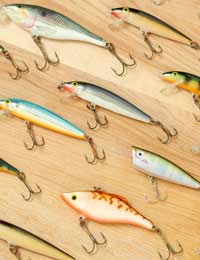Lure Fishing

Maggots, sweetcorn and worm catch roach, dace and bream. Lures attract and catch large predatory fish.
Lures are artificial bait made from wood, metal or plastic. They are shiny and brightly coloured. When retrieved through the water, lures rotate and vibrate and some even rattle! This movement, designed to imitate a vulnerable or injured fish, will tempt a hungry or curious predator to attack.
Lures can be fished all year round and in deep or shallow water. It is an effective method for catching salmon and trout. For the coarse angler using lures pike and perch are the normal target, although sometimes chub will take the bait.
Equipment
Some lures can be a heavy piece of tackle and specialist lure fishermen will use a sturdy rod of about 3 metres in length. For the novice angler a slightly longer general-purpose rod is suitable.A fixed-spool reel is easy to operate and the best reel to cast a lure a long way. Fit the reel with line of about 12lbs breaking strain. If you are hunting large pike in lakes and reservoirs attach a trace wire on the end of the line. Pike are quite capable of launching a savage attack on the lure and trace wire will withstand the snap of sharp teeth.
There are two general categories of lure: plugs and spinners.
Plugs
These are shaped like fish and have hooks attached. Plugs are designed to resemble prey of predatory fish. Plugs are very versatile lures. By altering the speed at which the handle on the reel is turned the plug will behave in a different manner. They can be made to dart and turn and sink and rise. This erratic movement perfectly matches the action of an injured or dying fish.Floating plugs are available and they can be used in shallow water for pike and chub. Turning the handle quickly will cause the floating plug to pop in the water encouraging a predatory fish to attack.
For the angler new to plug fishing, the Devon minnow is a good choice. As the name suggests, the Devon minnow is shaped like a small fish and is popular bait for catching salmon.
Spinners
Spinners are made from bright coloured metal or plastic and hooks are attached to the end of the spinner. When it is reeled in, part of the spinner rotates and makes vibrations and this stimulates the predatory nature of certain fish.As with plugs, if the handle of the reel is turned at various speeds then the spinner will perform different actions.
A recommended spinner to use is a small Mepps. When pulled through the water the flashing Mepps spinner is often irresistible to pike and trout.
Tips
Choose a spot for lure fishing where the surrounding area is relatively clear of vegetation because this will make casting easier.On large waters, like lakes and reservoirs, start casting to your left then gradually work round in an arc. This method of casting ensures all fishing areas are covered.
It is not always necessary to cast the lure great distances. If undisturbed, fish will feed close to the margins.
Don't be in a rush to lift the lure from the water because fish often attack at the last possible moment.
In dark or muddy waters, like ponds and canals, use a bright lure to reflect what little light there is.
Invest in a pair of polarized glasses. Wearing these will enable you watch the lure in the water and maybe spot the monster accelerating to pounce!


Re: Float Fishing
So I'm relatively new to fishing, to be honest I used to go with my dad and he used to set my rod up for me. I never tied rigs or anything so I guess…
Re: Fishing Holidays: Your Questions Answered
hi, i;m looking at getting a travel rod for mainly sea fishing but i also want to fish the occasional small pond…
Re: Trout Fishing
Hi, I’m trying to find somewhere I can go spinning for trout. I live near Swindon and dont mind a bit of travelling. I’ve searched online and every I…
Re: Trout Fishing
Hi I'm looking to fined out more about fly fishing for mullet and sea trout in Christchurch harbour...thank you.
Re: Equipment for Game Fishing
I know nothing about fishing tackle can you recommend a good rod reels line for fishing in the amazon and rivers in Guyana for large…
Re: Trout Fishing
Hi, where I can find places for trout fishing in norfolk?
Re: Fishing for Chub
This is a really good website and from this ive been catching chub on slugs maggots casters and worms rated 10 out of 10
Re: Is Fishing From a Road Bridge Over a River Legal?
Is it legal to fish next to a bridge without a permit even though the river is permitted
Re: Fishing For Flatfish
Hi im new to the whole fishing game but have recently been hooked onnit as i had a good day out with a keen fisherman. Will i catch plaice by…
Re: Getting Children Involved in Fishing
where in East Anglia is a good place to start to practice and teach my 6 year old girl to spin fish (lure angling…